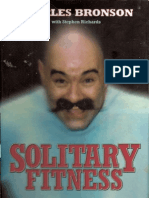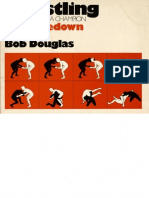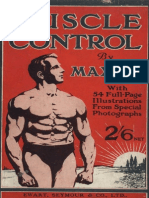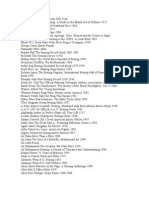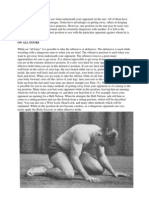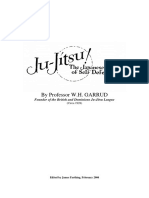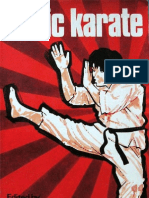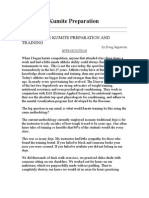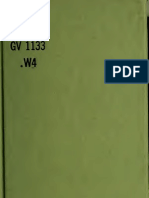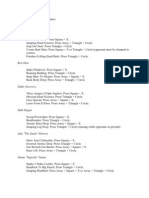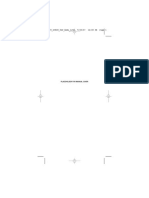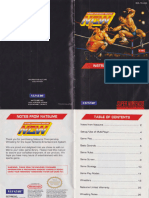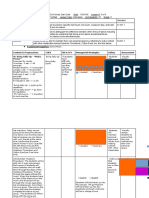EL61
EL61
Uploaded by
cgonzjamCopyright:
Available Formats
EL61
EL61
Uploaded by
cgonzjamCopyright
Available Formats
Share this document
Did you find this document useful?
Is this content inappropriate?
Copyright:
Available Formats
EL61
EL61
Uploaded by
cgonzjamCopyright:
Available Formats
EL61
mODERn
RECREATIOn
SERIES
SPORTS flnflLYSIS GROUP
CHICAGO PARK DISTRICT
PARK, CHICAGO
MODERN RECREATION SERIES
Sports Analysis Group
The Sports Analysis Group is being developed by the
Physical Activities Section of the Chicago Park District t o
foster the easier and more accurate acquisition of good
form in the sport under analysis. Wrestling, one o f the
group, has been promoted through the helpful co-operation
of Cl i f ford Cason, Andrew Kovach, and William Culp,
f or many years physical instructors in the Chicago Park
District. This booklet is designed as an instruction manual
and guide f or physical education groups in the Chicago Park
District. I t is hoped that i t may also aid in extending the
the services o f the Chicago Park District t o communities
and individuals that have only limited facilities in the physical
activities field.
Copyri ght 19*$ Chi cago Park District
COMP I L E D BY WORKERS O F THE WRI TERS
P R O G R A M O F THE WORK P R O J E C T S
A D M I N I S T R A T I O N - STA TE O F I L L I N O I S
W R E S T L I N G
* \ V / D In presenting the science o f wrestling t o the
I N t i I N novice, the holds described herein are divided
into three types: standing holds, holds worked from position behind opponent on
mat, and holds worked from the bottom position on mat. Although the layman
can probably learn much t o be desired from the following chapters, i t is advisable
t o work with the aid o f an instructor who will be better qualified t o interpret the
material.
The holds described and illustrated are, for the most part, standard amateur wrestling
holds, used in all countries of the world. Many combinations of holds which the
experienced wrestler would use have been necessarily omitted from the t ext mainly
for lack of space, and also f or the fact that as a wrestler becomes more advanced,
he will favor combinations of his own choice, originating from material presented
here. Blocks, breaks, and counters are included in the same sequence with the
holds, the purpose being to clarify which hold they are applied to. Most instruct
ors would not teach the holds with the block, break, and counter at the same time
as i t is reasonable t o believe that good teaching technique should require the indi
vidual t o become adept in applying a hold before being taught t o counter or block
it. I t is suggested that a series of holds be taught and that in a later lesson,
methods of escaping from the hold be explained. Naturally, an instructor would
elect t o teach a certain number of holds from each group rather than teach all stand
ing holds first.
Wrestling, although an international sport, has not developed a standard termin
ology for all the moves and counter moves that are employed. Consequently, i t
has been necessary t o use terms which are standard in Chicago area.
Rules governing barred holds, length of bouts, position behind and on the mat,
have been omitted purposely because they vary considerably in other sections
where the sport of wrestling is promoted and i t also was considered that by includ
ing them, the t ext would sooner become outdated.
CONTENTS
HOLDS WORKED FROM A STAND
ING POSITION
HOLDS WORKED FROM A TOP PO
SITION ON THE MAT
INTERLOCKING HANDS, INTERLAC
ING HANDS 70
HOLDS WORKED FROM A BOTTOM
POSITION - AND ESCAPES 71
DEFINITIONS 90
INDEX 91
HOLDSWORKED_____
FROM ASTANDING__
POSITION________ ___
Standing Position .................................. 4
Locked Position Standing .......................... 5
Double Leg Dive .................................. 6,7
Single Knee Drop, Go Behind ........................ 8
Single Leg Dive with Backheel...................... 9
Standing Switch .................................... 10,11
Front Headlock............................... . . 12,13
Front Headlock and Reverse Bar A r m .................. 14,15
Variation of Hip T h r o w ............................ 16
Single Reverse Vi'lnglock............................ 17
Double Reverse T,'lnglock............................18,9
The Dip from a S t a n d .............................. 20
Cross-Face, Far Arm Used to Go Behind............... 21
Side Chancery and Far A r m .......................... 22
Standing Go B e h i n d ................................ 23
Standing Arm Drag ............................... 24,25
Position Behind, Forward Trip ..................... 26
Position Behind, Standing Backheel ............... 27
Position Behind, Standing Body.lock and Throw . . . . 28
Counters and Breaks for Position Behind ............ 29
Standing Position
Generally, a wide stance should be taken,with one foot In advance of
the other. Imagine the feet as being on the diagonal corners of a
square. The knees are bent slightly, the body Is tilted forv/ard from
the hips, and the arms are carried half-bent and forward for both
defensive and offensive work. In taking steps forward or sideways,
use a follow step. Never cross the feet. Three of the many styles
of stance are shown in the accompanying illustrations.
Locked Position
Standing----------
HOLDi This Is a position wrestlers often take while standing to
work holds. It Is also an excellent position to use for exercise.
Try to throw your opponent off balance.
\ w
*
\
HOLD: The position Is widely used for exercise and helps develop
your neck muscles. Also helps you to be shifty and alert, as any
slow movement or crossing of your feet may result In your being
thrown to the mat. Always learn to remember the cardinal rule of
wrestling,"Do not cross your feet or get off balance."
Double Leg Dive
HOLD: Make a quick movement forward and grasp your opponent behind
the knees. Keep your head to the outside. Pull his legs In to you
and press your shoulder Into his midriff.
HOLD: Drive the man over backv.ards,
falling with him and keeping close.
BLOCK: Push on head and shoulder T aggressor
and step backward and to the side.
BREAK: Push
on mans head
and turn over.
COUNTER:
Front headlock
and bar arm.
Single Knee Drop,
Go Behind______
HOLD: Drop to the I:nee, going close to your opponent, and
catchhis forward leg with your Inside hand.
HOLD: Pull him to you and
come up to position behind.
BLOCK: Push on head
and shoulders.
Single Leg Dive
with Bacltheel _
BLOCK: Defensive wres
tler places leg In op
ponent ' s crotch and push
es on his head.
HOLD: Lift your oppo
nent's forward leg,using
both arms, and pull him
In close to you. Step
with your heel behind
his opposite leg.
COUNTER: V/lth your
leg In your oppo
nent's crotch,push
your shoulder Into
his midriff and go
to the mat with a
reverse bar arm.
Standing Switch
HOLD: Grasp opponent's opposite wrist, reach over the
captured arm, place hand In his crotch, keeping his arm
straight. Force him to the mat and get behind him.
Three variations are shown In illustrations 1, 2 and 3.
COUNTER: Throw your leg across your opponent's body and drive him to
the mat.
Front Headlock
HOLD: Catch your opponent's head in the crook
of your elbow, with your forearm alone the line
of his jaw. Interlock your hands anc' lift, turn
ing his head to the side.
BLOCK: push the forearm off and step away. This photo shows opposite
side of hold above.
BREAK: Pull opponent's hands apart and push his elbow,
pulling your head out.
COUNTER: Push Into opponent and gras'p his le
Front Headloclt______
and Reverse Bar Arm
:HOLD: The top man starts with a front headlock and applies the re
verse bar arm. He then moves around in the direction of the bar arm
and forces his opponent to the mat,staying close to him for the pin.
BLOCK: Push away from the
opponent.
BREAK: push on elbow of
aggressor,forcing his arm
off your head.
COUNTER: Drive In to the
aggressor and use a double
leg dive to take him to the
mat.
Variation of Hip Throw
HOLD: Working from a standing referee's position, grasp the oppo
nent's right elbow with your left hand, bring your right hand under
neath his arm and step In hard with a hip throw, throwing the man to
the mat.
Single Reverse
Winglocli____
HOLD: If you go underneath the man from a standing position and he
drops an arm over your hack, trap It with your arm above his elbow.
Sit down backwards, throwing the man over your hack. Release the
hold and,turning in, go behind him.
BLOCK Top man slips his elbow free.
Double Reverse
Wingloclt_____
HOLD: a man drops both hands over your back, trap both his arms
above the elbows. Sit down and throw the man backwards. Try a pin;
If you cannot, re lease the holdand turn In with your chest to his.
BLOCK: Slip the elbows out.
COUNTER: If the man sits down after you slip
out your elbows, remain on top of him.
The Dip From A Stand
HOLD: Prom a stand, grasp your opponents opposite wrist. Stepping
under his arm, place your other hand In his crotch.
HOLDt pull the opponents arm down, lifting him off his feet. Drop
to one knee and throw him over your head. Keep close to him and go
for the pin.
Cross face, Far A rm __
Used To Go Behind ___
HOLD: Secure- this hold by pushing the opponent's
left arm across his .
!
HOLDi Drop quickly to
the mat and spin around
behind the man,dropping
the hold as you go be
hind him.
COUNTER: Defensive wres
tler drops to the mat and
traps a leg.
Side Chancery
and Far Arm _
HOLDi Step across as if taking the
headlook and grasp the far arm with
both hands.
HOLDi Drop to your knees
and throw the man over your
back.
HOLD: Go to the mat
with him and pin his
shoulders to the mat.
This Is a dangerous
hold to use,as too of
ten the defensive man
will slip behind you.
Standing G o ---------
Behind
HOLDi In the locked po
sition standing, the ag
gressor pushes his oppo
nent's left arm upward
and slips his head under
the opponent's arm. He
then steps In close and
then behind him.
BLOCKt Push away and
turn in opposite di
rection.
BREAK Double wrlstlock.
Standing Arm Drag
There are many variations of this hold. The simplest is to grasp
the opponent's opposite arm, jerk him forward to the mat, fall with
him,and come up behind.
HOLD
HOLD
HOLD
Three variations of
the standing arm drag
are shown In illus
trations 1,2, and 3.
BLOCK: Run around In opposite direction or the arm drag.
COUNTER: Raise leg and execute a cross
body block, taking the man to the mat.
Position Behind,____
Forward T r ip _______
HOLD: From standing position behind, the offensive man steps In
front of the defensive man's foot and trips him directly forward.
After going to the mat, he may hook his legs together.
Position Behind, _
Standing Backheel
HOLDi Blocking your opponent's leg, with a
twist pull him backward to the mat.
HOLD: Continue turning as you hit the mat
to secure top position.
Position Behind,_
Standing Bodylock
and Throw
HOLDi After securing standing position behind,lift the opponent and,
turning him sldeways,drop with him to the mat,securing top position.
Counters and Breaks -
for Position Behind__
BLOCK: Use outside leg
grapevine to prevent a
man from lifting you.
BREAK: The defensive
wrestler arches back
and throws his arms
hack to break oppo
nent's hold.
COUNTER: The defensive
wrestler uses an ankle
grab and then sits down.
HOLDSWORKED
FROM
TOP POSITION
ON THEMAT
Referee's Position on the M a t ...................... 32
Par Arm Outside, Near Leg Outside.................. 33
The Arm Crush........................................ 34,35
Wrlstlock Used as a R i d e ............................ 36,37
Far Arm Outside...................................... 38,39
Far L e g .............................................. 40,41
Step Over Far L e g .................................. 42
Cradle Ho l d ........................................ 43
Near Arm Scissors and Far Half Nelson................ 44,45
Half Nelson ........................................ 46,47
Three-Quarters Nelson .............................. 48,49
Near Half Nelson and Far Wrlstlock................ 50
Far Half Nelson and Near Wrlstlock................ 51
Bar Arm and a Far Wrlstlock........................ 52
Bar Arm and Far Half Nelson........................ 53
Jackknlle............................................ 54,55
Leg Split............................................ 56,57
Double Outside Leg Grapevine and Reverse Head . . . . 58
Stretcher.......................................... 59
Body Scissors and Far A r m ............................ 60,61
Short Arm Scissors.................................. 62,63
Reverse Short Arm Scissors ........................ 64
Figure-Four Scissors .............................. 65
Figure-Four Scissors on the Head and Reverse Bar Arm 66,67
Cross-Body Ri d e ...................................... 68,69
Referee's Position
on the M a t _____
No set rule Is given for the position on the bottom, as this depends
on the physical build of the wrestler. The rules state that the
hands and feet must be In contact with the mat as the command to
wrestle Is given. Some coaches advise their wrestlers to sit well
back on their haunches,holding head and shoulders high. Others coach
their men to stay low. When staying low, cover the lowered legs with
the thighs and do not lay the elbows on the mat.
The top position must be started with the offensive wrestler having
one hand on the upper arm of the bottom man and his opposite arm over
his opponent's back and gripped loosely around the body.
Far Arm Outside,
Near Leg Outside
When working from the left side, reach In front of both arms
of the opponent and with your left hand grasp his right arm well
above the elbow;wlth your right hand grasp his thigh from the rear.
Keep the body close to defensive wrestler.
',71th a slight
lift turn him over and
pin his shoulde'rs to
mat. Keep weight well
back and on his chest.
Defensive wres
tler straightens l&r arm
and legs.
Arm Crush
HOLD! When holding a bodylock from right side, grasp opponent's
right wrist with your right hand and place your head behind his
upper arm. Force opponent's arm back and his shoulder to the mat.
BLOCK: Defensive man straightens arm forward.
BREAK: Defensive man flexes his arm and,
Interlocking his hands, pulls arm inward.
COUNTER! Hip throw-over or forward roll
Wristloclc Used
as a Ride____
HOLD: When working from the left side, use left hand to grasp left
wrist of the opponent. Using the forearm as a lever,force the man's
shoulders forward Into the mat, keeping your own weight well back.
Use a bodylock with the right arm.
BLOCK O H BREAK: Straighten the arm.
COUNTER: Use wlnglook.
Far Arm Outside
HOLDi When working from the left aide, reach In front of both arms
of your opponent with your left hand and behind both his arms v/lth
your right hand. Grasp his far arm with both hands and pull his arms
together.
HOLD: Keep close to your opponent and turn him over on his back.
Keep your weight well back and pin his shoulders to the mat.
BLOCK: Defensive wrestler straightens right arm before It Is
pulled In by the aggressor.
BREAK: Crawl around to right, face aggressor, and stand up
Far Leg
HOLD: When working from the left side, reach through with both your
arms and. Interlocking your hands Just above your opponent's knees,
pull both his legs together. Keep your chest close to the defensive
wrestler and turn him over.
HOLD: A variation for the hold above.
BLOCK: Defensive wrestler straightens right leg.
COUNTER: Use double wrlstlock.
Step Over Far Leg
HOLD: This Is primarily an off-balance hold from all fours. Lift
your opponent's near leg and, stepping over his far leg, turn him
over onto his side.
BREAK Bottom man Jumps forward quickly and turns away from the op
ponent .
Cradle Hold
HOLDi After you have worked an off-balance hold from all fours,
catch your opponent's far leg as he rolls, hook his head and Inter
lock your hands.
BREAK Hook the feet together and straighten
the legs.
Half Nelson
HOLDi When working from the left side, reach under your opponent's
left arm to the back of his head. Pry his head down and keep your
body close to him as you turn him over for a fall.
BLOCK: Defensive wrestler raises his head and lowers his shoulder.
COUNTER: Use wlnglock
Three-quarter
Nelson______
HOLD: When working from the left side, the aggressor puts his left
arm under the left arm of the opponent and over the back of the neck.
Interlocking his own hands.
HOLD: Blocking the opponent's leg, pull his head In
and tip him over on his shoulders for the fall.
BLOCK: Bottom man raises his head.
BREAKi Pull opponent's hands off your head.
COUNTER: Use wlnglock.
Near Arm Scissors
Far Half Nelson _
HOLDi When working from the right side of the opponent, obtain a far
half nelson and. If opportunity occurs, step forward and hook the op
ponent's right upper arm In the crook of your leg.
HOLD: Tip the man forward onto his shoulders.
BLOCK: Raise head and lower arm to break: half nelson,
lie down to prevent the opponent from turning you over.
BREAKt After the opponent has turned you over, kick both legs down
and bridge. Repeat this until you have worked your way clear.
Near Half Nelson and
Far Wristlock_______
HOLD: Y/hen working from the left, get a near half nelson with your
left hand. Reach over your opponent's back with your right hand and
grasp his right arm with a wristlock. Tip him over, using the half
nelson for leverage. Keep your weight well back and stay close to
your opponent for the fall.
BLOCK and BREAK Raise head and straighten arms.
COUNTER: Use wlnglock.
Far Half Nelson and
Near Wristlock-------
HOLD: 'Vhen working from the left side, reach over your opponent's
back and under his right arm with your right hand and hook It over
the back of his head. Trap his left arm with a wristlock. Turn him
In toward you with the half nelson and as he turns over on his back,
shift your body across to the other side for the pin.
BLOCK: straighten left arm to block wristlock, raise head to block
far half nelson.
Bar Arm and__
A Far Wristlock
HOLD: When working from the left side, reach In front of opponent's
left arm, hooking It with your left arm. Work your arm up between
his arm and body until your hand Is on his shoulder. Force his
shoulder to the mat.
HOLDi With your right arm you may use a far wristlock or bodylock.
Bar Arm and__
Far Half Nelson
HOLD: Preceding hold may he worked Into a bar arm and far half nel
son by changing the right hand to a half nelson.
HOLDi Shift your body to the far side and turn the opponent over
for the pin.
Jackknife
HOLD: Start the hold with a near half nelson and
near leg hold. Tip the man over forward and Inter
lock your hands. Keep your weight well back and
pin his shoulders to the mat.
BREAK: Scissor your leg and extend legs.
Leg Split
HOLD: When working from the right side, get a figure-four
leg grapevine on the bottom man's right leg. Reach across
your opponent's and interlock your hands on the Inside
of his left leg Just above the knee.
HOLDi Pull him toward you,then release your hand, using It
for your support,and pull his legs apart. For better lever
age In applying pressure, keep your left arm near his knee.
-
BREAK: Reach for the opponent's head and pull him
in to you with a headlock and straighten legs.
Double Outside_____
Leg Grapevine
and Reverse Head
HOLD: Turn your opponent over, straddle him, and
straighten your legs backward In a double-leg grape
vine. Secure a reverse head hold. Then stretch out
and arch your back to apply pressure for the pin.
BREAK Defensive wrestler grasps right hand of opponent,
pulls It off of his head,and turns over.
Stretcher
HOLD: From a top position, force your legs Into
your opponent's crotch and pull his arms forward.
Then arch your back and straighten out.
BLOCKi Defensive wrestler catches foot of the
offensive wrestler to prevent It from slipping
Into the grapevine.
Body Scissors
and Far Arm .
HOLD: This hold Is usually taken by pulling the opponent over
when he Is on all fours. Apply scissors and reach across the
body for a far arm. For the best results the scissors hold
should be taken over the floating ribs.
BREAK: Force the opponent's feet apart.
COUNTER: Keep turning and take the aggressive
Short Arm Scissors
HOLDi This hold Is applied when the
top man has worked around to the front.
HOLDi Start applying a reverse armlock, then
step over with your leg and grasp your own ankle.
HOLDi Apply pressure by tightening the hold and pushing
towards the defensive wrestler. Keep weight well back.
Use your free arm to prevent a back-roll.
BLOCK: Defensive wrestler grasps
hands and straightens the arm.
Reverse Short Arm
Scissors__________
HOLD: From top position, hook opponent's left arm from the Inside
with your left arm, step over his arm with your left leg and grasp
your ankle. Keep his wrist under his hip with your right hand. Brace
yourself with your right knee.
Figure-Four Scissors
HOLDi Start by forcing your leg around waist of the opponent and
hooking the knee of your other leg. Hook your leg behind the oppo
nent's leg. This hold Is used for a ride. Do not allow the oppo
nent to reach up and grasp your head. This hold maybe combined with
a headlock or a far arm for a pin.
BLOCK: Grab hold of the leg across your waist before It Is hooked
and pull It away.
Figure-Four Scissors on
the Head and Reverse
Bar A r m ____________
HOLD: When on top, work around to the front and apply a reverse
bar arm to tip your opponent over and bring his head Into your
crotch. Hook your foot over your opponent's opposite arm, straight
en his arm, and force his shoulders to the mat.
BREAK: Defensive wrestler separates legs of the aggressor and
turns over.
Cross-Body Ride
HOLD: When working from the right side of the opponent, start the
hold by getting an Inside leg grapevine on his right leg with your
right leg. Reach over his back and hook your left arm around the
left arm of the opponent and interlock hands.
HOLD: This Is a
riding hold and Is
seldom used for pin
ning. After you get
the hold,stay there.
If the man rolls over
keep the hold.
BLOCK: Trap the leg and
prevent the aggressor from
getting a grapevine.
BREAK: Bottom man turns over and forces the Inside arm between his
body and opponent's body.
BREAK: Turn In toward him and go to top position
INTERLOCKING
HANDS
Interlocking Hands: Cupping the
ringers and locking hands with
one another Is known as Inter
locking the hands.
INTERLACING________
HANDS________
Two Variations
Interlacing Hands: (Illegal) In
tertwining or the Tlngers. This
movement Is prohibited to pre
vent Injury to the ringers.
HOLDSWORKED____
FROM BOTTOM____
POSITION - AND____
ESCAPES____________
Single Wlnglock .................................... 72,73
Sit-Through.......................................... 74,75
Arm Hook and Far Arm Across the P a c e .............. 76
Sit-Through and Arm D r a g .......................... 77
S w i t c h .............................................. 78,79
Outside Leg Grapevine and Underarm ................ 80
Leg Hook and Wrist R o l l ............................ 81
An Inside Leg H o o k .................................. 82,83
Forward Somersault ................................ 84
Hip Throw-Over to Come from Underneath ............ 85
Double Wrlstlock .................................. 86,87
Keylock .......................................... 88
Arm and Head P u l l .................................. 89
Single Wingloclt__
HOLD: When working from the left side, bottom man hooks the
top man's right arm above the elbow with his right arm.
HOLD: Pull the top man forward and sideways to turn him over.
Then make a half turn and place your body crosswise to your
opponent. Let go his arm and turn with your chest to his.
BLOCKi Top man steps over to the other side with right leg.
COUNTER: Half nelson and far wrlstlock
Sit-Through__
HOLDi Def enslve wrestler comes from a posi
tion on all fours to a sitting position.
HOLD. ,He arches his back to break the top
man's hands apart, turns, and stands up.
BLOCKi Man behind grasps the ankle of opponent.
COUNTER. When working from the left side the man behind reaches
over with his right arm and underneath the opponent's right arm.
COUNTER! Man behind bars opponent's left arm with his left
arm, puts right hand across face,and turns head to the side.
COUNTERi A possible follow-hold to pin the man.
Arm Hook__________
and Far Arm
Across The Face
HOLDi As the bottom man slts-through,grasp his right arm with
your left, than secure cross-race arm with your right.
HOLD: Pull him baclcward for the pin.
Sit-Through and
Arm Drag _____
HOLD: In a sit-through.when top man has a bar arm, break the waist
hold. Then,using an arm drag, go behind.
Switch
HOLD: The bottom man slts-through, reaches back with his right arm
over his opponent's right arm, and places his right hand on the in
side of his opponent's right thigh. He then arches his back and
forces his opponent to the mat.
HOLDi Turn fully right going behind the opponent.
BLOCK: Grasp the bottom man's left arm above the elbow to keep him
fi'om turning.
COUNTER: Step over the opponent's body with the right leg.
Outside Leg Grapevine
and Underarm______
HOLD; When the top man Is working on the bottom man's left, the
bottom man hooks his right leg over the right leg of his opponent. He
then turns outward and goes under his opponent's right arm,continues
to turn over and comes up behind his opponent.
BLOCK: Top man straightens right leg
Leg Hook and
Wrist Roll___
HOLDi When top man Is working from the left side, bottom man hooKs
right leg over the right leg of top man and grasps right wrist of
opponent with his right hand.
HOLDt Roll to the right carrying opponent
with you and turn over facing him.
BLOCK: Top man
straightens out
and lies down to
the left.
Inside Leg Hook_____
HOLDi Bottom man hooks his Inside leg over his opponent's Inside
leg and sits directly backward,pulllng the top man's leg Inward and
forcing him over backward.
HOLDi He then turns in and comes up on top of his opponent.
COUNTER! Top man raises arm across opponent's face,pull
ing him backward and sideways and remains on top.
Forward Somersault
HOLD: Straighten the
legs and do a forward
somersault over the
arm that Is applying
the bodylock, coming
toaneutral position.
BLOCK: Trap his leg, preventing him
from turning over.
COUNTER: As the opponent turns over, shift your
hips across his body.
Hip Throw-Over---------
Come from ___
__________Underneath
HOLD: Bottom man straightens
out,throws hips and legs over
top man's In order to
gain position on top.
Double Wristlock
HOLD> The bottom man hooks the arm that Is over his body and grasps
the opponent's left wrist with h-ls right hand and grasps his own
right wrist with his left hand.
HOLD: He then
turns Inward,
forcing up his
opponent's arm,
and comes out
on top.
BLOCK: Top man shifts his hips to the front and over the arms of
his opponent.
BREAK: From the block position grasp your own hand and pull upward.
The Keylock
HOLD: A follow up of the double -wrlstlock by coming on around to
the front and shifting your opposite hand to the wrist and wrapping
the other arm around the opponent's arm.
HOLD: It Is sometimes
worked as the opponent
tries a slt-through,by
getting a wrlstlock on
his Inside hand and
then going directly In
to the keylock.
BREAK: Before the op
ponent has the arm all
the way behind you,In
terlock your hands and
straighten your arms.
Arm and Head Pull
HOLDi The bottom man often works this when he slts-through and falls
to get free. If the opponent's head Is too far forward, reach up and
grab It In a head-and-armlock and pull him over your shoulder.
BREAK: Top man steps quickly around to the front and pushes his
body into the opponent's.
DEFINITIONS
AGGRESSOR: The wrestler who Is attacking or advancing.
ALL FOURS: Position of a man on his hands and knees on the mat.
BLOCK: Any movement that is performed by the defensive wrestler to
prevent his opponent from taking or securing a hold.
BREAK: Any movement that Is performed by the defensive wrestler to
break a hold which the aggressor has taken.
BRIDGE: Done by arching the back and neck Into a span bend using
the head to lift shoulders free of the mat to prevent a pin.
COUNTER: A hold secured by the defensive wrestler which will coun
teract the opponent's hold and give defensive wrestler advantage.
DEFENSIVE WRESTLER: The man who 1 s on the defensive and upon whom
the hold Is being worked is known as the defensive wrestler.
FAR ARM OR FAR LEG: The arm or leg of the opponent which Is far
thest from the man behind when the wrestlers are In the referee's po
sition on the mat (see Illustration on p. 32).
GRAPEVINE: The leg of one wrestler intertwined with the leg of the
opponent.
INTERLACING HANDS: (Illegal) Intertwining of the fingers. This
movement Is prohibited to prevent Injury to the fingers.
INTERLOCKING OF HANDS: Cupping the fingers and locking the hands with
one another Is known as Interlocking the hands.
NEAR ARM OR LEG: The arm or leg of the opponent which Is near
est the man behind when the wrestlers are In the referee's position
on the mat (see Illustration on p. 32).
OFF-BALANCE HOLD: Used to take a man to the mat or while on the mat
to break down the position on all fours.
OFFENSIVE WRESTLER: The man who Is the aggressor and worklng the
hold Is called the offensive wrestler.
REFEREE'S HOLD: (Standing) This Is really a misnomer, as wrestlers
are not required to take any set position while In a standing posi
tion. It Is used, however, to describe the position where two wres
tlers Interlock In head-to-head position.
RIDING HOLD: Any hold that is taken primarily to keep the position
behind In preventing the defensive wrestler from escaping.
INDEX
fours................................... (definition) 2
Arm,
- and head pu l l ....................................... 89
bar -,
- and far half nelson............................. 53
- and a far wrlstlock............................. 52
figure-four scissors on the head and - ......... 66-67
front headlock and reverse - ................... 14-15
- crush............................................ 34-35
- drag, slt-through and .............................. 77
far - ..................................... (definition) 2
arm hook and - across the fa c e .................... 76
body scissors and - ............................ 60-61
cross face, - used to go behind................... 21
- outside,..................................... 38-39
- .near leg outside........................... 33
side chancery and - ............................... 22
- hook and far arm across the f a c e .................... 76
near - .................................. (definition) 2
- scissors and far half nelson............... 48-49
short - scissors,.................................. 62-63
reverse - ............................... . . . . . 64
standing - d r a g .................................... 24-25
gackheel,
single leg dive with - ................................. 9
standing - , position behind ...................... 27
Bar arm,
- and far half nelson................................. 53
- and a far wrlstlock................................. 52
reverse - ,
figure-four scissors on the head and - .............66-67
- and front headlock............................ 14-15
Block ........................................ (definition) 2
Body,
position behind, standing - lock and throw............ 28
- scissors and far a r m ............................. 60-61
Bottom position, holds worked from .................... 72-89
Break ........................................ (definition) 2
Breaks for position behind................................ 29
Bridge........................................ (definition) 2
Qradle h o l d ............................................. 43
Chancery and far arm, side................................ 22
Counter ...................................... (definition) 2
Counters position behind............................... 29
Cross-body r i d e ........................................ 68-69
Cross-face, far arm used to go behind.......................21
Crush, a r m ............................................. 34-35
Qefenslve wrestler............................ (definition) 2
Dip from a stand.......................................... 20
Dive,
double leg - ......................................... 6-7
single leg - with backheel.............................. 9
Double,
- leg di v e ........................................... 6-7
- outside leg grapevine and reverse head ............... 58
- reverse wlnglock ................................ 18-19
- wrlstlock..................................... .86-87
Drag,
slt-through and arm - ................................. 77
standing arm - ..................................... 24-25
Drop, go behind, single knee................................8
pace, arm hook and far arm across the ................... 76
Far,
- a r m , .................................... (definition) 2
arm hook and - across the face................... 76
body scissors and - . . . . . . . . . . 60-61
cross-face, - used to go behind
outside - , ..........
- , near leg outside
side chancery and - . .
- half nelson,
bar arm and - .........
near arm scissors and -
- and near wrlstlock . .
- leg........................ .2 (definition),40-41
step over - ............
- wrlstlock.
bar arm and - ..........
near half nelson and . .
Forward somersault ..............
Forward trip, position behind . .
Fours, a l l ......................
Front headlock, ................
- and reverse arm bar . . . .
Figure-four scissors, ..........
- on the head and reverse bar arm . .
Q o behind,
cross-face, far arm used to - .........................21
- , single knee d r o p .................................. 8
standing - ............................................ 23
Grapevine..............................
double outside leg - and reverse head
outside leg - and underarm ........
(definition) 2
........... 58
80
|-|1 nelson,........................................... 44-45
far - and near wrlstlock.............................. 51
near - and far wrlstlock.............................. 50
near arm scissors and - ............................ 48-49
Hands,
Interlacing - ......................... def. 2, lllust. 70
Interlocking - ........................ def. 2, lllust. 70
Head, arm and - pu l l ...................................... 89
double outside leg grapevine and reverse - ............. 58
figure-four scissors on the and reverse bar arm . . .66-67
Headlock, front......................................... 12-13
- and reverse bar a r m ............................. 14-15
Hip,
- throw-over to come from underneath................... 85
variation of - throw................................... 16
Hold,
cradle - ............................................... 43
off-balance - ...............................(definition) 2
referee's - ................................ (definition) 2
riding - .................................. (definition) 2
Holds,
- worked from bottom position ...................... 72-89
- worked from a standing position .....................4-29
- worked from a top position.........................32-69
Hook,
arm - and far arm across the face.................. 76 76
Inside leg - ........................................ 82-83
leg - and wrist ro l l ....................................81
Interlacing hands ........................ def. 2, lllust. 70
Interlocking hands........................ def. 2, lllust. 70
Jackknlf e ..............................................54-55
K e y l o c k ................................................................................................................... 88
Knee drop, go behind, single .............................. 8
[_eg,
-dive,
double - ........................................... 6-7
single - with backheel............................... 9
far - .......................... 2 (definition), 40-41
step over - ......................................... 42
- grapevine and reverse head, double outside
- hook and wrist roll ....................
58
81
Inside - h o o k ....................................... 82-83
near - ................................... (definition) 2
far arm outside, - outside........................... 33
outside - grapevine and underarm ....................... 80
-spilt.............................................. 56-57
Locked position standing ................................ 5
y^at, referee's position on t h e ...........................32
|\Jelson,
half - ............................................ 44-45
bar arm and far - ................................... 53
far - and near wrlstlock............................ 51
near - and far wrlstlock............................ 50
near arm scissors and far - ...................... 48-49
three-quarters - .................................... 46-47
Near,
- arm, (definition) 2
- scissors and far half nelson................. 48-49
- half nelson and far wrlstlock........................ 50
- leg, .................................... (definition) 2
- out side, far arm outside....................... 33
far half nelson and - wrlstlock.................... 51
- wrlstlock, far half nelson a n d ...................... 51
Qutslde,
far arm - ........................................ 38-39
far arm - , near leg - ..................................33
- leg grapevine and reverse head, double .............. 58
- leg grapevine and underarm........................... 80
position,
- behind,
counters and breaks for - .........................29
- , forward t rip..................................^26
- , standing backheel ............................ 27
- , standing headlock and throw .................. 28
bottom - , holds worked from 72-89
locked - standing..................................... 5
referee's - ........................................... 32
standing,.............................................. 4
holds worked from - ............................. 4-29
top - , holds worked f r o m ...........................32-69
Pull, arm and h e a d ........................................ 89
[Referee's hold .............................. (definition) 2
Referee's position on the m a t ............................. 32
Reverse,
- bar arm,
figure-four scissors on the head and - ......... 66-67
front headlock and - ...........................14-15
- head, double outside leg grapevine a n d .............. 58
- short arm scissors.................................. 64
- wlnglock,
double - ....................................... 18-19
single - .......................................... 17
Ride,
cross-body - ....................................... 68-69
wrlstlock used as a - .............................. 36-37
Roll, leg hook and wrist.................................. 81
gclssors,
body - and far a r m ................................. 60-61
figure-four - ......................................... 65
- on the head and reverse bar a r m .............. 66-67
short arm - , ...................................... 62-63
reverse - ......................................... 64
Side chancery and far a r m ................................. 22
Single,
- leg dive with backheel............................... 9
- knee drop, go behind........................ 8
- reverse wlnglock.................................... 17
- wlnglock............................................ 71
Slt-through, - ......................................... 74-75
- and arm drag........................................ 77
Somersault, forward ...................................... 84
Step over far l e g ......................................... 42
Split, l e g ............................................. 56-57
Stand, dip from a ......................................... 20
Standing,
- arm d r a g ......................................... 24-25
- backheel, position behind .......................... 27
- bodylock and throw, position behind ................ 28
- go behind........................................... 23
locked position - ...................................... 5
- position.............................................. 4
holds worked from a - ........................... 4-29
- switch........................................... 10-11
Step over far l e g ......................................... 42
Stretcher................................................. 59
Switch.................................................. 78-79
standing - ......................................... 10-11
"phree-quarters nelson................................. 46-47
Throw,
position behind, standing bodylock and - .............. 28
variation of hip - ....................... 16
Throw-over to come from underneath, h i p ................... 85
Top position, holds worked f r o m ........................ 32-69
Trip, position behind, forward............................ 26
JJnderarm, outside leg grapevine and....................... 80
Underneath, hip throw-over to come fr o m .................... 85
yarlatlon of hip throw................................... 16
^lnglock,
reverse - ........................................ 18-19
double - .......................................... 17
single - ................................... . 72-73
single -
Wrestler,
defensive - .............................. (definition) 2
offensive - .............................. (definition) 2
Wrlstlock,
double - ........................................... 86-87
far - ,
bar arm and - ..................................... 52
near half nelson and - ............................ 50
near - and far half nelson............................ 51
- used as a ri d e .................................. 36-37
You might also like
- Bronson Solitary FitnessDocument310 pagesBronson Solitary Fitnesstcorey793% (100)
- Youth Football ConditioningDocument2 pagesYouth Football ConditioningJason Sanchez100% (1)
- Rajko Petrov. Freestyle and Greco-Roman WrestlingDocument258 pagesRajko Petrov. Freestyle and Greco-Roman Wrestlingandriy11296% (25)
- Choi Hong Hi - Tae Kwon Do Teaching ManualDocument167 pagesChoi Hong Hi - Tae Kwon Do Teaching Manualcgonzjam100% (2)
- Dynamic Judo Grappling TechniquesDocument220 pagesDynamic Judo Grappling TechniquesJuan Jose Opazo Carvajal100% (10)
- Douglas B. Wrestling The Making of A Champion The Takedown PDFDocument196 pagesDouglas B. Wrestling The Making of A Champion The Takedown PDFandriy112100% (13)
- Submission Fighting and The Rules of Ancient Greek Wrestling (Pale) - Christopher MillerDocument38 pagesSubmission Fighting and The Rules of Ancient Greek Wrestling (Pale) - Christopher Millerchef_samuraiNo ratings yet
- Bare Knuckle Boxer's ChampionDocument165 pagesBare Knuckle Boxer's Championgypsylantern100% (28)
- Strongfortism - The Complete Course From 1931Document57 pagesStrongfortism - The Complete Course From 1931adiseif100% (4)
- Maxick Muscle ControlDocument131 pagesMaxick Muscle ControlcmonBULLSHIT96% (23)
- Gerhard Schmitt. SavateDocument73 pagesGerhard Schmitt. Savatekickara100% (4)
- My Method of Self Defense by MIKONOSUKE KAWAISHIDocument61 pagesMy Method of Self Defense by MIKONOSUKE KAWAISHIcmonBULLSHIT67% (3)
- The Complete Kano Jiu-Jitsu - Jiudo - The Official Jiu-Jitsu of the Japanese Government: With Additions by Hoshino and Tsutsumi and Chapters on the Serious and Fatal Blows and on Kuatsu the Japanese Science of the Restoration of LifeFrom EverandThe Complete Kano Jiu-Jitsu - Jiudo - The Official Jiu-Jitsu of the Japanese Government: With Additions by Hoshino and Tsutsumi and Chapters on the Serious and Fatal Blows and on Kuatsu the Japanese Science of the Restoration of LifeRating: 5 out of 5 stars5/5 (1)
- Libros Boxing y MasDocument73 pagesLibros Boxing y Mascgonzjam100% (1)
- Libros Boxing y MasDocument73 pagesLibros Boxing y Mascgonzjam100% (1)
- Ringmaster3 0Document93 pagesRingmaster3 0duce_bishopNo ratings yet
- GlimaDocument39 pagesGlima1n5h6d100% (1)
- New of Karate Manual Green To BlackDocument32 pagesNew of Karate Manual Green To Blackprivateinvestigation100% (1)
- No Holds Barred Fighting: The Clinch: Offensive and Defensive Concepts Inside NHB's Most Grueling PositionFrom EverandNo Holds Barred Fighting: The Clinch: Offensive and Defensive Concepts Inside NHB's Most Grueling PositionRating: 3 out of 5 stars3/5 (5)
- No Holds Barred Fighting: The Ultimate Guide to Submission WrestlingFrom EverandNo Holds Barred Fighting: The Ultimate Guide to Submission WrestlingRating: 5 out of 5 stars5/5 (1)
- LG19Document88 pagesLG19cgonzjam100% (2)
- (1897) A Handbook of Wrestling - E.R. PeltonDocument265 pages(1897) A Handbook of Wrestling - E.R. PeltonSamurai_Chef100% (3)
- (1925) Ground Fighting Positions of Catch Wrestling - Paul PrehnDocument3 pages(1925) Ground Fighting Positions of Catch Wrestling - Paul PrehnSamurai_Chef100% (1)
- Judo 41 Lessons in Jiu Jitsu - KuwashimaDocument163 pagesJudo 41 Lessons in Jiu Jitsu - KuwashimaRamos CezarNo ratings yet
- Modern Judo Volume 1Document150 pagesModern Judo Volume 1DrancyNo ratings yet
- Aesw 1Document482 pagesAesw 1nikos180729983100% (1)
- (1939) Le Catch As Catch Can - Arnold Bontemps, Felix Miquet & Albert ArnaudDocument20 pages(1939) Le Catch As Catch Can - Arnold Bontemps, Felix Miquet & Albert ArnaudSamurai_ChefNo ratings yet
- (1912) Scientific Wrestling - George BothnerDocument169 pages(1912) Scientific Wrestling - George BothnerSamurai_Chef100% (2)
- Celtic Wrestling The Jacket StylesDocument183 pagesCeltic Wrestling The Jacket StylesMethleigh100% (3)
- Jiu JitsuDocument136 pagesJiu Jitsudavidash07100% (2)
- Jiu Jitsu Complete (PDFDrive)Document180 pagesJiu Jitsu Complete (PDFDrive)Antonio BastosNo ratings yet
- Jiu Jitsu Complete ManualDocument56 pagesJiu Jitsu Complete ManualMarcello Arias Cano100% (3)
- (1937) Standing Catch-As-Catch-Can Wrestling (Bacon's Style)Document60 pages(1937) Standing Catch-As-Catch-Can Wrestling (Bacon's Style)Samurai_Chef86% (7)
- Muay ThaiDocument24 pagesMuay ThaiGM Kru Alvaro Ovando100% (2)
- Kawashi Secrets On AtemiDocument17 pagesKawashi Secrets On AtemiOurs2f100% (1)
- (1905) American Wrestling Vs JujitsuDocument14 pages(1905) American Wrestling Vs JujitsuSamurai_Chef100% (2)
- 3 - Garrud W. H. - Ju-Jitsu The Japanese Art of Self DefenceDocument44 pages3 - Garrud W. H. - Ju-Jitsu The Japanese Art of Self DefenceJonathan Chacón100% (1)
- 1854 Catch Wrestling BookDocument74 pages1854 Catch Wrestling BookJason Spotts92% (13)
- Joint LocksDocument21 pagesJoint LocksjasenkoĐNo ratings yet
- Catch WrestlingDocument6 pagesCatch WrestlingChristiano Martins Milfont de Almeida100% (1)
- Kodokan Goshin JutsuDocument50 pagesKodokan Goshin Jutsudiamond68100% (1)
- Usjjf-Bjj Rank Reqrmts 20 June 2015 PDFDocument42 pagesUsjjf-Bjj Rank Reqrmts 20 June 2015 PDFJonathan Camacho100% (1)
- Savate Students Manual PDFDocument41 pagesSavate Students Manual PDFCikal Wahyudi Al-KrangganiNo ratings yet
- (1916) How To Wrestle Catch As Catch Can - E. Hitchcock JR and R. F. NelliganDocument174 pages(1916) How To Wrestle Catch As Catch Can - E. Hitchcock JR and R. F. NelliganSamurai_Chef100% (11)
- (1915) Boxing - R.G. Allinson-WinnDocument111 pages(1915) Boxing - R.G. Allinson-WinnSamurai_Chef100% (2)
- Super Karate Made EasyDocument111 pagesSuper Karate Made EasyapramanauNo ratings yet
- Basic KarateDocument50 pagesBasic KarateRodolpho MorethsonNo ratings yet
- Jissen Issue 5Document84 pagesJissen Issue 5sri999No ratings yet
- How To Wrestle - Instructions of Frank GotchDocument66 pagesHow To Wrestle - Instructions of Frank GotchDecameron100% (2)
- Celtic Wrestling ManualDocument84 pagesCeltic Wrestling ManualcmonBULLSHIT100% (10)
- (Uilliah H. HortellDocument180 pages(Uilliah H. HortellWilliam100% (3)
- (1823) Wrestliana: Or, An Account of Ancient & Modern WrestlingDocument178 pages(1823) Wrestliana: Or, An Account of Ancient & Modern WrestlingHerbert Hillary Booker 2ndNo ratings yet
- (1887) Art of WrestlingDocument56 pages(1887) Art of WrestlingSamurai_Chef100% (1)
- Cano of Judo Text PDFDocument249 pagesCano of Judo Text PDFDemetrius Thomas Nosb100% (1)
- Competitive Kumite Preparation and TrainingDocument19 pagesCompetitive Kumite Preparation and Trainingramrocky100% (1)
- KarateDocument16 pagesKaratefernando gonzalezNo ratings yet
- The Secrets of Jujitsu - A Complete Course in Self Defense - Book TwoFrom EverandThe Secrets of Jujitsu - A Complete Course in Self Defense - Book TwoRating: 2 out of 5 stars2/5 (1)
- Wrestling - Catch-As-Catch-Can, Cumberland & Westmorland, All-In StylesFrom EverandWrestling - Catch-As-Catch-Can, Cumberland & Westmorland, All-In StylesNo ratings yet
- More No Holds Barred Fighting: Killer SubmissionsFrom EverandMore No Holds Barred Fighting: Killer SubmissionsRating: 3 out of 5 stars3/5 (1)
- Savate The Deadly Old Boots Kicking Art from FranceFrom EverandSavate The Deadly Old Boots Kicking Art from FranceRating: 5 out of 5 stars5/5 (1)
- Takefuji GoshinJutsu1940Document132 pagesTakefuji GoshinJutsu1940cgonzjam100% (3)
- Bag Punching For He 00 DuncDocument56 pagesBag Punching For He 00 Dunccgonzjam100% (2)
- Takefuji GoshinJutsu1940Document132 pagesTakefuji GoshinJutsu1940cgonzjam100% (3)
- Professor Atilla's Five Pound Dumb-Bell ExerciseDocument76 pagesProfessor Atilla's Five Pound Dumb-Bell ExerciseCullen O'Gorman87% (23)
- (1916) Counter Back On A Counter Boxing Without A Teacher - O.S. WestermanDocument64 pages(1916) Counter Back On A Counter Boxing Without A Teacher - O.S. WestermanSamurai_Chef88% (8)
- LG19Document88 pagesLG19cgonzjam100% (2)
- Japanese Physic A 00 Han C GoogDocument233 pagesJapanese Physic A 00 Han C GoogcgonzjamNo ratings yet
- Taekwon-Do The Art of Self DefenceDocument305 pagesTaekwon-Do The Art of Self Defencecgonzjam100% (1)
- Mcfadden S System o 00 Mac FDocument144 pagesMcfadden S System o 00 Mac FcgonzjamNo ratings yet
- Free GymnasticsDocument85 pagesFree Gymnasticscgonzjam88% (8)
- Shorinji Kempo. JuhoDocument111 pagesShorinji Kempo. Juhocgonzjam78% (9)
- Manuel de Gymnastique Du 1 Fevrier 1893Document124 pagesManuel de Gymnastique Du 1 Fevrier 1893cgonzjamNo ratings yet
- Science of Muscular DevelopmentDocument183 pagesScience of Muscular Developmentcgonzjam100% (1)
- Street Fighting - America's Martial Art - George CarpenterDocument60 pagesStreet Fighting - America's Martial Art - George Carpentershaqtim100% (11)
- Zivic DirtyDocument8 pagesZivic DirtycgonzjamNo ratings yet
- OneUpBasketball Beginner Drills PlanDocument15 pagesOneUpBasketball Beginner Drills PlanEmiNo ratings yet
- Volumes: The Sandow-Lewis System TrainingDocument62 pagesVolumes: The Sandow-Lewis System Trainingtkaye7732No ratings yet
- Wwe 2k15 Ps4 Online Manual EngDocument26 pagesWwe 2k15 Ps4 Online Manual Engravish0% (1)
- WWE CheatsDocument5 pagesWWE Cheatspsych2085No ratings yet
- Drills Hoover: Defensive LineDocument10 pagesDrills Hoover: Defensive Linejgordon1No ratings yet
- PYD Handbook PDFDocument23 pagesPYD Handbook PDFCarlos André100% (1)
- Wwe SVR 2008 PSP ContorlsDocument11 pagesWwe SVR 2008 PSP Contorls123No ratings yet
- Scott Kuehn Performance Warm-Up TemplateDocument5 pagesScott Kuehn Performance Warm-Up Templateyohan mironNo ratings yet
- Wwe13 Wii OnlinemanDocument21 pagesWwe13 Wii OnlinemanrockettekcorNo ratings yet
- 3 Count Bout MovesDocument7 pages3 Count Bout MovesBadcatsaNo ratings yet
- Bujinkan Takagi Yoshin Ryu DenshoDocument25 pagesBujinkan Takagi Yoshin Ryu DenshoNick Doornebosch100% (1)
- REGRAS CHEERLEADING USASF Cheer Rules EarlyRelease 21-22-3!5!21Document45 pagesREGRAS CHEERLEADING USASF Cheer Rules EarlyRelease 21-22-3!5!21Iguassu CorretoresNo ratings yet
- Natsume Championship Wrestling (USA) - TextDocument14 pagesNatsume Championship Wrestling (USA) - TextdarthviagraNo ratings yet
- Systematically Attacking From Open Guard Seated Position-FlowChart 1.1Document1 pageSystematically Attacking From Open Guard Seated Position-FlowChart 1.1Josh Wexler0% (1)
- T S 1257 Activities To Develop Gross Motor Skills Activities BookletDocument25 pagesT S 1257 Activities To Develop Gross Motor Skills Activities BookletAnar Vafa BayramovlarNo ratings yet
- Well." Example: "I Aced That Test Today."Document6 pagesWell." Example: "I Aced That Test Today."lipdanNo ratings yet
- WWE 2K17 FinishersDocument6 pagesWWE 2K17 FinishersAnonymous HMWt76YZNNo ratings yet
- Tekken Tag TournamentDocument78 pagesTekken Tag TournamentCARLOS ALBERTO MILLAN CURINo ratings yet
- 2kswin Wwe2k23 Ps5 Online Manual EngDocument23 pages2kswin Wwe2k23 Ps5 Online Manual EngBobby Timonio NelsonNo ratings yet
- Progressive Muscle RelaxationDocument4 pagesProgressive Muscle RelaxationEstéphany Rodrigues ZanonatoNo ratings yet
- World Wide Wrestling: Basic Moves: BooksDocument13 pagesWorld Wide Wrestling: Basic Moves: BookststjkdNo ratings yet
- Arm Jive Basic, Push PullDocument18 pagesArm Jive Basic, Push PullmeNo ratings yet
- CAS Gamesfor KidsDocument13 pagesCAS Gamesfor KidsDeneshwaran RajNo ratings yet
- Hoedown ThrowdownDocument6 pagesHoedown Throwdownapi-277611497No ratings yet
- Wwe 2K20Document8 pagesWwe 2K20Auroch SpiritNo ratings yet
- Juggernaut MethodDocument35 pagesJuggernaut Methodhmpzttmg8bNo ratings yet
